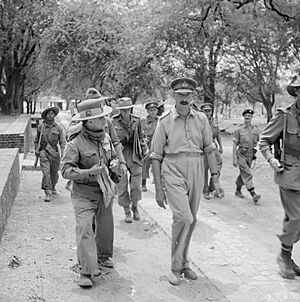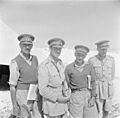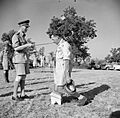Oliver Leese facts for kids
Quick facts for kids
Sir Oliver Leese, 3rd Baronet
|
|
|---|---|
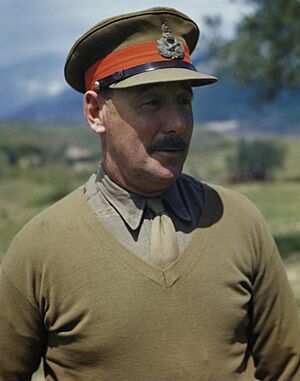
Leese in Italy on 30 April 1944
|
|
| Nickname(s) | "Baron Leese" |
| Born | 27 October 1894 Westminster, London, England |
| Died | 22 January 1978 (aged 83) Llanrhaeadr, Wales |
| Allegiance | United Kingdom |
| Service/ |
British Army |
| Years of service | 1914–1947 |
| Rank | Lieutenant General |
| Service number | 1722 |
| Unit | Coldstream Guards |
| Commands held | Eastern Command (1945–47) Allied Land Forces South-East Asia (1944–45) Eighth Army (1943–44) XXX Corps (1942–43) Guards Armoured Division (1941–42) 15th (Scottish) Infantry Division (1941) West Sussex County Division (1940–41) 29th Infantry Brigade (1940) 20th Independent Infantry Brigade (Guards) (1940) 1st Battalion, Coldstream Guards (1936–38) |
| Battles/wars | First World War Second World War |
| Awards | Knight Commander of the Order of the Bath Commander of the Order of the British Empire Distinguished Service Order Mentioned in Despatches (2) Commander of the Legion of Merit (United States) Légion d'Honneur (France) Croix de Guerre (France) Virtuti Militari (Poland) |
Lieutenant General Sir Oliver William Hargreaves Leese, 3rd Baronet (born October 27, 1894 – died January 22, 1978) was an important officer in the British Army. He served with great courage in both the world wars. He led the XXX Corps in North Africa and Sicily. He worked under General Sir Bernard Montgomery. Later, he took charge of the Eighth Army during the Italian Campaign for most of 1944.
Contents
Early Life and First World War Service
Oliver William Hargreaves Leese was born in London on October 27, 1894. He was the first of four children. His father, William Hargreaves Leese, was a lawyer. Oliver went to Ludgrove and Eton. While at Eton in 1909, he joined the Officers' Training Corps (OTC), which trained future army officers.
When the First World War began, Oliver joined the British Army. He became a second lieutenant in the Coldstream Guards in September 1914. After only five weeks of training, he was sent to France in October 1914. He joined the 3rd Battalion, Coldstream Guards, near Ypres, Belgium. A week before his 20th birthday, he was wounded by shrapnel. This was the first of three times he would be wounded during the war.
He returned to England to recover. In 1915, he went back to France and served with the 2nd Battalion, Coldstream Guards. He experienced trench warfare for most of that year. In July, he was wounded again, this time in the face, but he kept serving. In September, his battalion fought in the Battle of Loos. On October 3, Leese was promoted to lieutenant.
Leese was wounded for a third time during the Battle of the Somme in September 1916. For his bravery in this battle, he was mentioned in official reports (mentioned in despatches). He also received the Distinguished Service Order (DSO), a medal for great bravery. The award said he led an attack against a strong enemy position. He personally fought many enemies and helped the attack succeed, even though he was wounded.
Between the World Wars
After the war, Oliver Leese stayed in the British Army. He was promoted to captain in 1921. From 1927 to 1928, he attended the Staff College, Camberley, which trains army leaders. In November 1929, he became a brigade major and was promoted to major. He became a lieutenant-colonel in July 1933.
On January 18, 1933, Leese married Margaret Alice. They did not have any children. In September 1938, he was sent to India. He worked as an instructor at the Staff College in Quetta. He became the 3rd Baronet after his father passed away in January 1937.
Second World War Service
Fighting in France and Belgium
The Second World War began while Leese was still in India. He was eager to return to Europe to fight. His wish came true in March 1940. He returned to England and took command of the 20th Independent Infantry Brigade (Guards).
When Germany invaded Western Europe on May 10, Leese was sent to France. He became the Deputy Chief of Staff for General Lord Gort, who led the British Expeditionary Force (BEF). On May 11, he was promoted to major general. As the situation worsened, Leese helped plan the BEF's retreat to Dunkirk. He was evacuated himself on May 31. During this difficult time, Leese was known for being calm and confident. He helped bring order to the BEF's withdrawal and evacuation.
After returning to the UK, Leese formed and trained the 29th Infantry Brigade. In December 1940, he was promoted to major general again. He commanded the West Sussex County Division. A month later, he became the leader of the 15th (Scottish) Infantry Division.
He was then chosen to lead the new Guards Armoured Division. This division had armored regiments and infantry. Leese worked hard to get what he needed from the War Office (the government department in charge of the army). He pushed his men to train hard and create a well-organized division quickly.
Campaigns in North Africa and Sicily
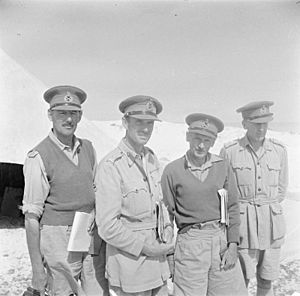
In September 1942, Leese was sent to Egypt. He was requested by Lieutenant General Bernard Montgomery, who led the British Eighth Army. Leese took command of XXX Corps. Montgomery had a high opinion of Leese from their time at Staff College.
Leese led XXX Corps during the Second Battle of El Alamein and for the rest of the North African Campaign. This campaign ended in Tunis in May 1943. He was again mentioned in official reports for his service.
After a short break, XXX Corps took part in the Allied invasion of Sicily in July–August 1943. After Sicily, the corps returned to the UK to prepare for the Allied invasion of Northwest Europe. In September, Leese was promoted to temporary lieutenant general.
Leading the Army in Italy
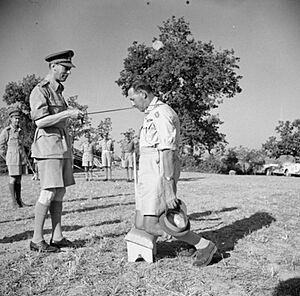
On December 24, 1943, Leese was ordered to Italy. He took over from Montgomery as the commander of the Eighth Army. When Leese arrived, the Eighth Army had stopped advancing. It and the American Fifth Army were stuck in front of the German Winter Line. His army stayed in place until May 1944. This gave him time to get to know his soldiers and units.
In May 1944, he led his army during the fourth and final battle of Monte Cassino. Later that year, he directed his army during Operation Olive, an attack on the Gothic Line. This was a victory, but it did not end the fighting in Italy as hoped. Leese did not enjoy working with Mark W. Clark, who commanded the American army. His rank of lieutenant general became permanent in July 1944.
Operations in Burma and the Far East
In late September 1944, Leese was appointed Commander-in-Chief (C-in-C) of the Eleventh Army Group in India. This group directed operations in Burma. He took command in November, when it was renamed Allied Land Forces, South-East Asia (ALFSEA). Leese thought the way things were organized was not efficient. He brought in staff members from his old Eighth Army. This caused some tension because the new staff had different ways of working.
ALFSEA fought a successful campaign in Burma. This led to the recapture of Rangoon in early May 1945. Rangoon had been lost to the Japanese in 1942. Leese believed that Lieutenant General William Slim, who commanded ALFSEA's Fourteenth Army, was tired. He suggested that Slim should be replaced. Leese chose Lieutenant General Philip Christison as a possible replacement. Christison had experience in amphibious warfare (landings from the sea), which would be useful for the next attack to retake British Malaya. Leese then chose Slim to lead the new Twelfth Army, which would handle easier tasks in Burma.
Leese thought Slim agreed with these changes. However, Slim felt he had been fired. He told his staff this and wrote to Leese and General Sir Claude Auchinleck to say he would refuse the new job and resign. When this news spread, there was strong opposition within the Fourteenth Army. Without support from his superiors, Leese had to give Slim his old command back. This political problem led to Leese being removed from his command. Slim then replaced him.
Life After the War
Leese's military career suffered after this event. He returned to the UK to lead Eastern Command. This was a much less important role than being an army group commander. It is thought that his promotion to full general was blocked. Leese retired from the army in January 1947.
After leaving the army, Leese became a well-known gardener. He wrote books about cacti and had a famous garden at his home in Worfield, Shropshire. He was also a keen cricketer and served as President of the Marylebone Cricket Club in 1965. In 1958, he was the High Sheriff of Shropshire.
In 1973, his right leg was amputated. His wife, Margaret, had passed away in 1965. Leese moved to Wales. He died there from a heart attack on January 22, 1978, at the age of 83. He was buried at Worfield parish church.
Images for kids


